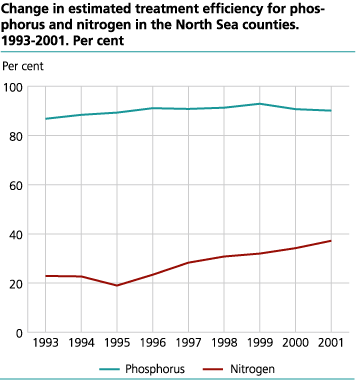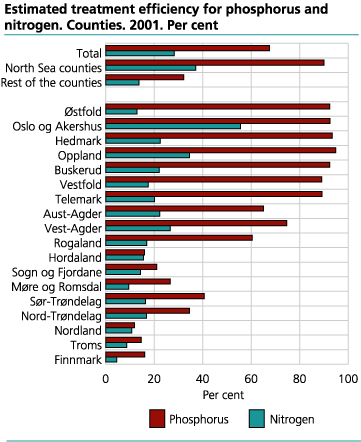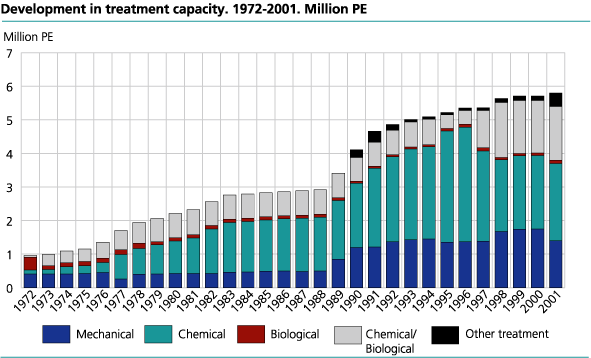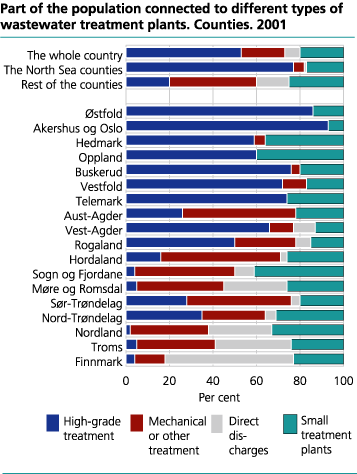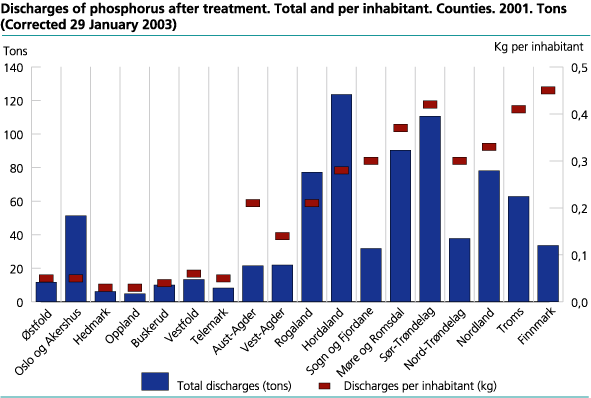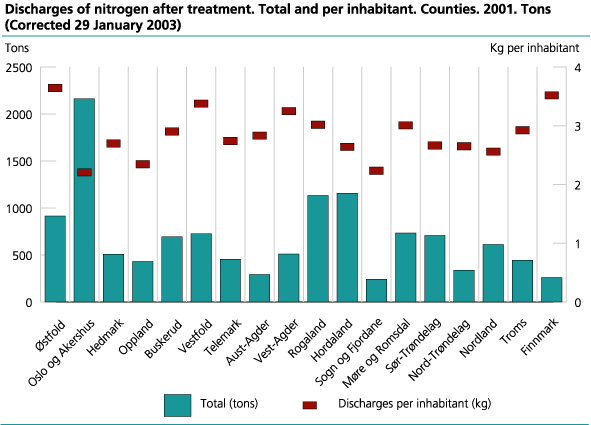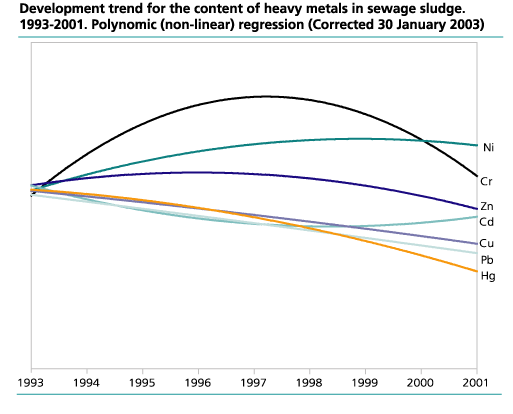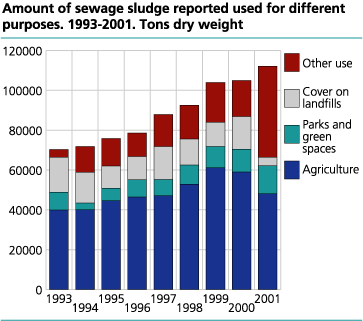Content
Published:
This is an archived release.
More nitrogen removed
The Norwegian treatment plants are constantly removing more nitrogen. For the whole country, the treatment efficiency for nitrogen has increased by 2 per cent between 2000 and 2001. The largest increase is registered in the North Sea counties, where treatment efficiency for nitrogen increased from 34 to 37 per cent within the same period.
Reports on discharges and treatment of municipal wastewater include all treatment plants with a capacity of 50 population equivalents (p.e.) or more. The 2001 statistics shows that the trend from the 1990s continues according to national goals; with a continuous improvement on nitrogen removals and a stabilized sufficient removal of phosphorus.
Since 1993 the treatment efficiency in the North Sea counties (Østfold through Vest-Agder) has increased by 3.3 per cent for phosphorus and 14.3 per cent for nitrogen. This rather strong increase is mainly due to upgrading of treatment plants in order to fulfill treaties on discharge reductions to the North Sea.
The inner parts of the Oslo fjord and the areas around the outlet of the river Glomma are areas sensitive to nitrogen discharges. During 2000 and 2001 two treatment plants in the Oslo area, covering about 300 000 residents, have been upgraded on nitrogen removal. The increase in treatment efficiency for nitrogen in the North Sea counties is mainly due to these two upgradings.
Half the population connected to high-grade treatment plants
In 2001 a total of 2639 municipal treatment plants with a capacity of 50 p.e or more were registered. 1939 of these plants carried out some type of treatment, while 700 discharges wastewater without ant treatment. In 2001 there were registered 813 treatment plants less than the year before. This is mainly due to municipal efforts to emerge small plants into larger units.
Hydraulic capacity (a measure for treatment capacity) for municipal treatment plants in 2001 is estimated to around 5.77 million p.e., an increase of one per cent from 2000. In addition plants with direct discharges constitute a capacity of 0.05 million p.e. Plants with high-grade treatment (plants using chemical and/or biological methods of treatment) contributed 63 per cent of the total treatment capacity, while mechanical and other methods contributed the remaining 37 per cent. In the North Sea counties high-grade treatment methods represented 93.7 per cent of the total capacity, while these methods represented only 24.5 per cent in the rest of the country. Since 1990 chemical-biological treatment capacity compared with the total capacity has increased from 17 to 28 per cent, while the total treatment capacity has increased by 41 per cent. The registered treatment capacities prior to 1990 are considered uncertain due to changes in reporting systems and routines. The same goes for the distribution of capacity between the different treatment categories up to 2001.
In 2001 81 per cent of the population were connected to treatment plants with a capacity of 50 p.e. or more. The remaining 19 per cent were connected to small treatment plants, mainly individual plants, not connected to the municipal pipeline system. Just above 52 per cent of the population were connected to high grade treatment plants. For the North Sea counties this percentage was 77, and for the rest of the country it was 20 per cent.
The discharges of nutrients are decreasing
The total discharges of phosphorus and nitrogen from municipal treatment plants in 2001 were 795 and 12303 tonnes respectively. This is a decrease of 3.6 per cent for phosphorus and 6.7 per cent for nitrogen compared with 2000. Direct discharges represented a total of 182 tons phosphorus and 1384 tons nitrogen.
The discharge of phosphorus and nitrogen from treatment plants is a function of the loads of wastewater and the treatment efficiencies of the plants. This is also reflected in the per inhabitant figures for discharges in different parts of the country. The authorities have invested particularly in effective treatment plants in the counties draining to the North Sea. In the North Sea counties the per inhabitant discharges of phosphorus were 0.06 kilograms, while the corresponding figure for the rest of the country was 0.32 kilograms. For nitrogen the differences between regions are less visible, mainly because of less efficient treatment plants, with the exception of the Oslo fjord area.
Less heavy metal in the sewage sludge
The reported figures on the content of heavy metal in sewage sludge for 2001 show a decrease in the average contents of most heavy metals. The trend from the 1990s continues, with a possible exception of cadmium, for which the trend is less unambiguous.
The contents of heavy metal are one of the decisive factors defining the uses of sewage sludge. Sludge with contents below certain marginal limits is treated and used on agricultural land and in parks and other green spaces.
For 2001 the municipal reports on sludge disposal show a total of 112000 tonnes dry weight used for different purposes. This is an increase of nearly 7 per cent compared with 2000. In 2001 56 per cent of all sewage sludge was used as fertilizer. 15 per cent was reported in a new category labeled "Unknown disposal", which is a part of the category "Other use" (see table 4).
The relatively significant change between 2000 and 2001 regarding the different categories of disposal can be explained with the new option to report unknown disposal in the 2001 questionnaire.
Tables:
- Table 1 Number of municipal treatment plants. By county. 2001
- Table 2 Discharges of phosphorus by county and treatment methods. 2001. Tons
- Table 3 Discharges of nitrogen by county and treatment methods. 2001. Tons
- Table 4 Disposal of sewage sludge. By county. 2001. Tons dry weight
- Table 5 Content of heavy metals in sewage sludge. The whole country. 2001. Milligrams per kilo dry weight
Contact
-
Gisle Berge
E-mail: gisle.berge@ssb.no
tel.: (+47) 48 12 19 97

